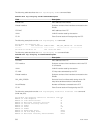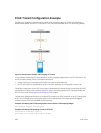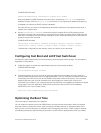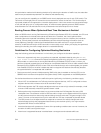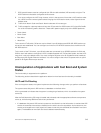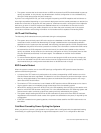this optimization method while booting the device. By reducing the duration of traffic loss, the subscriber
sessions are processed and preserved in an effective and seamless way.
You can configure this capability on an S6000 switch that is deployed as a top-of-rack (ToR) switch. The
ToR switch is the single point of connection to the network for servers in that rack. This functionality of
minimized reload time is supported in a network deployment in which the servers are connected through
a ToR, leaf and spine unit or configuration setup. An exterior border gateway protocol (EBGP) session
exists between the ToR and leaf switch units, and between the leaf and spine units or nodes.
Booting Process When Optimized Boot Time Mechanism is Enabled
When an S6000 switch running Dell Networking OS earlier than Release 9.3(0.0) is reloaded, the CPU and
other components on the board are reset at the same time. Therefore, the control plane and the
forwarding plane are impacted immediately. After the system boots up and re-initializes, the interfaces
come up, control plane protocols are reestablished, and the network topology information (such as
routes, adjacency settings) is learned and installed before the traffic resumes. In a typical network
scenario, a traffic disconnection of 150 seconds or more usually occurs. When you employ the optimized
booting functionality, the traffic outage duration is reduced drastically.
Guidelines for Configuring Optimized Booting Mechanism
Keep the following points and limitations in mind when you configure the fast boot capability:
• Fast boot is supported only when you perform an expected, stipulated reload by using the reload-
type normal-reload command in Global Configuration mode or by using the reset command in
uBoot mode on a switch that is running Dell Networking OS Release 9.3(0.0) or later, or when you
perform a planned upgrade (and not an abrupt or unexpected shutdown) from an older release of Dell
Networking OS to Release 9.3(0.0) or later. Dell recommends that you do not downgrade your system
from Release 9.3(0.0) to an earlier release that does not support the fast boot functionality because
the system behavior is unexpected and undefined.
• Fast boot uses the Symmetric Multiprocessing (SMP) utility that is enabled on the Intel CPU on the
S6000 Switch to enhance the speed of the system startup. SMP is supported on the S6000 platform.
For the fast boot feature to reduce the traffic disruption significantly, the following conditions apply:
1. When LACP is used between the ToR switch and the adjacent devices, LACP is configured on these
adjacent devices with a timeout value of 90 seconds or longer.
2. BGP timers between the ToR switch and adjacent devices are set to high values (for example, a hold
timeout of 180 seconds) unless BGP graceful restart is used.
3. Before performing the planned reload, we recommend that the IPv6 Neighbor Discovery (ND)
reachable timer is increased to a value of 300 seconds or longer on the adjacent devices to prevent
the ND cache entries from becoming stale and being removed while the ToR goes through a CPU
reset. This timer can be restored to its prior value after the ToR has completed its planned reload.
4. The BGP protocol on the adjacent devices responds to network (link-state) changes and route
advertisements quickly and propagates these further up the network quickly. You might need to
adjust the BGP timers on these devices.
5. Note that fast boot will operate even if some of the preceding conditions are not met. However, the
duration of traffic loss might be longer.
6. Warm boot is supported because it enables faster convergence and reduced traffic loss.
344
Flex Hash and Optimized Boot-Up



